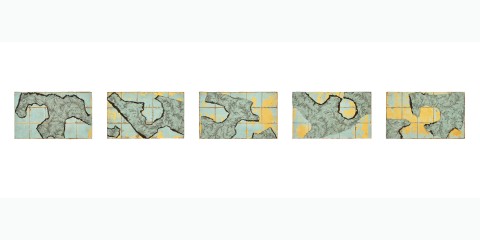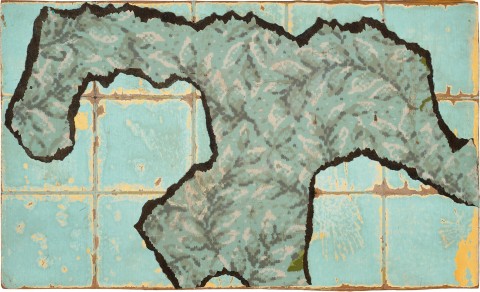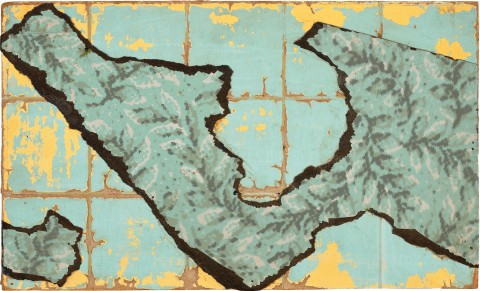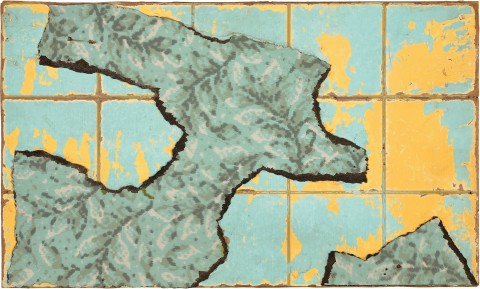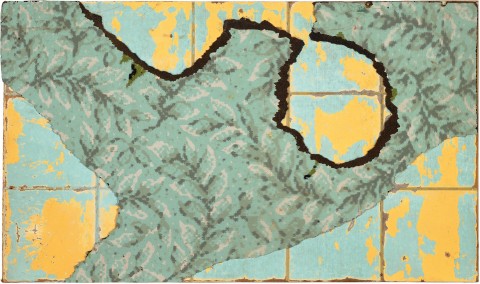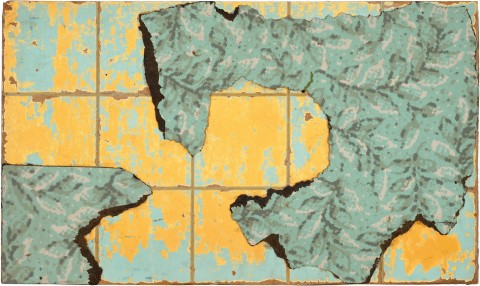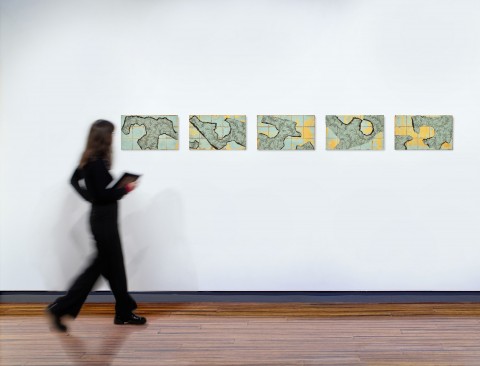ARCHIPELAGO, 1993
ROSALIE GASCOIGNE
torn and cut patterned linoleum on treated Masonite panels on composition board
five panels
30.5 × 50.5 cm (each)
left panel: signed, dated and inscribed with title verso: ARCHIPELAGO / Rosalie Gascoigne / 1993 / 1. / LEFT AS FACING WALL
each panel inscribed with the numbers 1 to 5
Collection of the artist, Canberra
Thence by descent
Private collection, Canberra
Rosalie Gascoigne, Pinacotheca, Melbourne, 5 - 22 May 1993, cat. 5
Rosalie Gascoigne, Roslyn Oxley9 Gallery, Sydney, 22 April - 22 May 2004, cat. 12
Gascoigne, M., Rosalie Gascoigne. A Catalogue Raisonné, ANU Press, Canberra, 2019, cat. 465, pp. 70, 115, 261 (illus.), 339, 352
Anderson, P., ‘An Eye for Poetry in the Ordinary’, The Australian, 11 May 2004, p. 14
Quintessentially ‘Australian’ materials such as corrugated iron and linoleum appear early in Rosalie Gascoigne’s oeuvre, often alluding to the physical hardships of colonial settlement and attempts to cultivate the land, while managing to capture ephemeral sensations specifically related to an experience of this continent – feelings of heat, light, air, space, and of making one’s way through the landscape.1 While Gascoigne categorically denied the connection to domesticity evoked by the use of humble household linoleum in her works,2 as a letter to her son Toss reveals, she was clearly drawn to the potential of its gaudy, high-keyed colours and its richly decorative patterns:
‘Another domestic buy I made is abt [sic.] 8 metres of Clarke [sic.] rubber lino… It is gaudy, with colour-photo flowers – seed packet plus. Very blue and peach and yellow and white and green – delphiniums, roses, daisies, peonies – the lot. The young man looked at it with distaste and said ‘you can have the lot for $10, we'll never sell it. There's about $80 worth there.’ ‘Done’ I said. After all, I can reline the kitchen cupboards if worst comes to the worst.’3
Made late in the artist’s career, Archipelago, 1993 demonstrates the way in which Gascoigne returned to her vast material stockpiles over the decades, using a particular material when both the mood and intuition inspired her. Between 1977 and 1993 she made around fifty works with lino, with over fifteen different patterns, in what was, in her words, a ‘twenty-year love affair’.4 As the artist’s studio assistant, Peter Vandermark has observed, Gascoigne ‘liked the hazard of not knowing’,5 and would have initially worked on the individual units of Archipelago with no predetermined sense of its final scale. On completion, the individual panels would similarly have sat in her studio for a time before being named. Gascoigne preferred to allow her works to simply ‘be’, waiting until the moment when the work itself presented an evocative title that managed to open up, rather than shut down, its allusive possibilities.
It is through this astute combination of name and material form that the pieces of torn linoleum in Archipelago transform into a group of islands floating in the sea, their jagged coastlines viewed from above as if in an old-school atlas. Yet despite the sense of mystery and nostalgia that recollection of this activity invites, in the twenty-first century, Archipelago’s evocation of a cluster of potentially vulnerable islands on a map cannot help but transcend the artist’s initial intentions, becoming a poetic meditation on power, borders and boundaries, and the impacts of climate change. Given Gascoigne’s description of herself as ‘a sideways thinker’,6 one can fairly assume that she would have enjoyed the new and vital associations that the work continues to bring. As she has said: ‘I like going foraging with an open mind and happening upon things. It is a non-binding sort of art. I can fly off at tangents and be diverted by the unexpected. I read somewhere of ‘lyrical derangements.’ It fits my approach.’7
1. Rosalie Gascoigne’s first major work in corrugated iron was Standing Piece, 1973 – 74; her first works in linoleum were River Banks, 1977 and Step Through, 1977/c. 1979 – 80. Gascoigne, M., Rosalie Gascoigne: A Catalogue Raisonné, Australian National University Press, Canberra, 2019, pp. 63 & 159
2. Artist’s notes on Step Through, 1977/c. 1979–80, dated 24 February 1987, National Gallery of Australia artist file
3. Gascoigne, R., Letter to Toss Gascoigne, c. 10 June 1979, supplied to the author by Martin Gascoigne. Martin Gascoigne states the lino purchased from Clark Rubber was never used: see Gascoigne, M., 2019, op. cit., p. 114
4. The artist, lecture delivered at Auckland Art Gallery, July 1999. Transcript in Auckland Art Gallery Library, cited in Gascoigne, ibid., p. 115
5. Vandermark, P., cited in Gascoigne, ibid., p. 70
6. Macdonald, V., Rosalie Gascoigne, Regaro Pty Ltd, Sydney, 1998, p. 12
7. Gascoigne, R., cited in Bottrell, F., The Artist Craftsman in Australia, Jack Pollard Pty Ltd, Crows Nest, New South Wales, 1972, p. 39
KELLY GELLATLY
